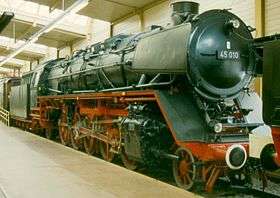Smoke deflectors


Smoke deflectors, sometimes called "blinkers" in the UK because of their strong resemblance to the blinkers used on horses, and "elephant ears" in US railway slang, are vertical plates attached to each side of the smokebox at the front of a steam locomotive. They are designed to lift smoke away from the locomotive at speed so that the driver has better visibility.
Overview
Smoke deflectors became increasingly common on later steam locomotives because the uplift of smoke exiting the chimney had been reduced as the result of efficiency gains obtained by improved smokebox design and reduced back pressure on the cylinders.[1]
Styles
Various styles of smoke deflectors have been used by different railway operators. However, many are essentially a variation of one of two designs of Windleitbleche (wind deflecting plates) developed by the Deutsche Reichsbahn-Gesellschaft (the German State Railway Company between the World Wars): the earlier, larger Wagner-type deflector, and the later, smaller Witte-type deflector.[2][3]
References
- ↑ "S class steam locomotives". Retrieved 2007-03-31.
- ↑ "Monday Train Blogging: Design Dictators". European Tribune - Community, Politics & Progress. Retrieved 2007-03-31.
- ↑ "Doch was ist eine Baureihe?". Retrieved 2007-03-31.